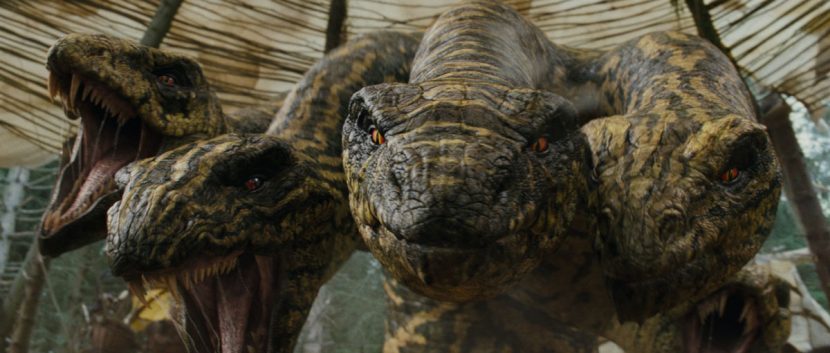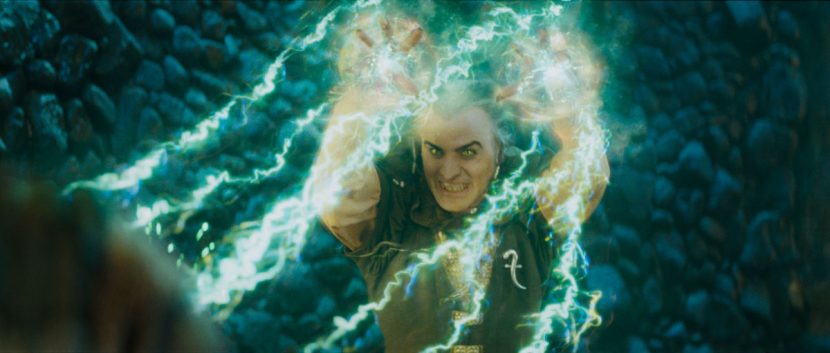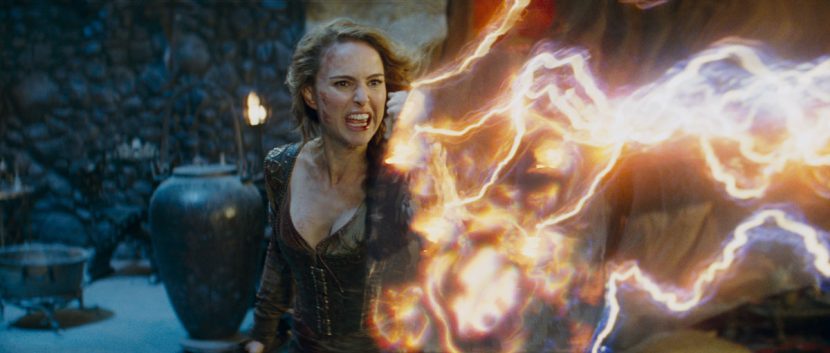Your Highness is the medieval tale of two princes, brothers Thadeous and Fabious, and their attempt to rescue the later’s future bride, Belladonna, who has been kidnapped by the evil wizard Leezar. Joined by aide Courtney and warrior Isabel, the group encounter wizards, savages and strange creatures on their quest.
Framestore completed around 570 shots for the film, including a five-headed serpent, a flying mechanical bird, matte paintings, set extensions and much magic. In this interview with fxguide, Framestore co-founder and the film’s visual effects supervisor Mike McGee delves into how he collaborated closely with the Your Highness filmmakers on both a creative and technical level, and on unexpected CG solutions.
fxg: Can you tell me about how you got involved on the film?
Mike McGee: Danny McBride, who is both a writer on the film and the actor playing Thadeous, and the director, David Gordon Green, came over to Framestore to go through the script, but they said in advance if we had any ideas to throw them into the mix. So I talked through the script and discussed how we could achieve what was already in there, and as we were talking, I was then offering up moments where visual effects could add some real production value and put dollars on the screen.
fxg: You then took on the role of the overall visual effects supervisor. What did that involve initially?
McGee: Well, we filmed in Belfast for four months in the Summer of ’09. I went out a month and a half before filming so that I could be there for the whole pre-production process. I became involved in how much of the set we would build, how much would be topped up in CG, the locations where matte paintings could help to provide bigger vistas, and the bigger creature sequences in terms of what we could do practically and digitally.
fxg: How did you contribute to say the serpent creature sequence?
McGee: When I was first there, we had sequence where a creature would burst out of another body and it would be half human, half alien. But we decided there was something more we could do to make that scene have more production value. So they asked if I could come up with an idea for an alternative creature. So I sat down with the writer, the director and the production designer and this image popped into my head of a five-headed creature. I thought we could build one CG creature and multiply it five times. As I made the shape with my arm, I rested my elbow on the table and made my hand into the five heads. Everybody said, ‘That’s great – we’ll do a hand serpent!’ Then the writer said we could make it like a video game where the bad guys control the creature by putting his hand into a bowl of sick.
 So this big bucket of sick became the game’s controller and this guy punches his fist into this bowl of yellow-looking sick, and as he moves his hand around inside the bucket, this monster bursts out of this arena out of the ground. And then this fight ensues. Our heroes pull out swords and then through various jumps and leaps they slice one by the one the heads off the creature. Each time they slice a head off, the guy loses one of his fingers in the bowl of sick. At the end of the shot, he pulls his hand out of the sick and he’s just left with his bird finger. It was quite bizarre movie-making!
So this big bucket of sick became the game’s controller and this guy punches his fist into this bowl of yellow-looking sick, and as he moves his hand around inside the bucket, this monster bursts out of this arena out of the ground. And then this fight ensues. Our heroes pull out swords and then through various jumps and leaps they slice one by the one the heads off the creature. Each time they slice a head off, the guy loses one of his fingers in the bowl of sick. At the end of the shot, he pulls his hand out of the sick and he’s just left with his bird finger. It was quite bizarre movie-making!
fxg: That sounds great that as the VFX supe you were able to have that kind of contribution.
McGee: Actually after the idea of the hand serpent, the guys were like ‘This is great, you’re ideas are great – let’s keep collaborating,’ and I’d be invited to meetings about other parts of the script. It was really the most collaborative film I’ve ever worked on. At Framestore, we now have our own art department that works on projects, but we’ve also worked on films, even if we’re not doing the visual effects on those films. We designed the hand serpent and did all the concepts in-house to show the director what it would look like, but still worked closely with the production designer.
fxg: Was that serpent sequence something you also ‘boarded and previs’d?
McGee: We did all our own previs. Before that, the director actually said, ‘Go away, here’s the storyboard artist, you block this out and show it to me when you think you’ve got a good sequence’. So I briefed the storyboard artist, and then the director had a look and made a few changes. Then the storyboard artist went back to Framestore to get everything previs’d and the director then signed off on the previs. When we went to the set, we pretty much shot to the previs. We might change the lens occasionally. It involved a lot of stunts as well, so things changed when we realised what we could do – the stunt people were offering up some amazing new ideas.
fxg: How were those serpent scenes shot?
McGee: Before each set up, I would go to the individual actors, whether it was Natalie Portman playing Isabel or James Franco as Fabious, and say, ‘There’s the creature, there’s the guy with a fishing pole and that’s where the eyeline is for head number four – you’ll be chopping that off and then we’ll move to position number two where you’ll be attacked by head number one’. We had a fishing rod for rehearsals but then when we shot the scene they did filmed it with just the actors. If we needed to do stunts, we’d have to rig a jerk wire, then we’d bring in the stunt person. Natalie Portman had a big action sequence and she would run in and then we’d cut to a stunt double on a trampette so she could fire up into the air and do several somersaults before she came down.
 fxg: This is a comedy and it’s set in medieval times, but there are a lot of effects in the film. Did that mean you approached it any differently to other projects?
fxg: This is a comedy and it’s set in medieval times, but there are a lot of effects in the film. Did that mean you approached it any differently to other projects?
McGee: Well as you say the fact is that it’s a ‘medieval stoner comedy’ – which was the way we referred to it – with comedy being the key emphasis. If we were on set and something funny happened, then we would go with it. For example, we did a sequence with some magical CG fairies. There was a scripted scene that was two or three pages, and we were shooting this exterior nighttime scene, and they were struggling to make the scene funny, so David had some alternative lines written down and would then would encourage them to ad lib – quite often to the limit of what would be acceptable.
The VFX had to be able to follow that ad lib path. In one of the sequences, the guy caught a fairy that was fluttering around a pond. At first you think they’re fireflies and so he grabs it very gently. And then we go in for a close-up and he starts to pull the wings off this creature and it starts squirming in his hand. And then he rips the head off and then takes the body and crushes it in his hand and snorts it through a pipe. It’s meant to be a magic fairy and so he’s snorting magic dust which he gets high on. The shots changed from the storyboard because the way he acted it out was just very funny on the day, so we went with a different method. Although we weren’t really doing groundbreaking things from a CG point of view, the way we were capturing data and keeping up with the improvisation was one of the most challenging things. You don’t want to stop the flow of the comedy – it’s funniest when it keeps going and going and having the camera keep rolling. You can’t get your camera passes until the scene is finished, so we would normally wait until the end of a roll and then jump in and grab what we could.
fxg: What were some of the other major sequences Framestore worked on, the bird Simon for example?
McGee: The director wanted to pay homage to early fantasy sci-fi films and the original Harryhausen Clash of the Titans film. So on set they had an animatronic bird which was something the actors could perform with, and is the bird in many of the shots. But whenever that bird had to take off or fly or carry messages or help out in any of the action fight sequences, it had to be CG.
fxg: There’s a lot of magic in the film too – how was that created and what approach did you take to the electricity effect?
McGee: Well there are a lot of wizards that fire magic as a weapon. And the magic comes out in the shape of electricity from a staff or the palms of hands. The director wanted this to be an homage to magic from the past, so he didn’t want the effects to be super-glossy and Harry Potter-style. He wanted it to be a little more man-made, but still look like a modern visual effect. So we came up with this magic that fires from people’s hands and then we have a big action sequence at the end, where the wizard has taken his virgin bride that he has reared from a child, which he is going to impregnate with dragon seed – and then she’ll give birth to this dragon which he will then control and rule the kingdom. He has to impregnate her at the time of twin moons. When they eclipse he is able to impregnate her, so the film is moving to this climax of the twin moons. The ceiling of the observatory opens up to let the moonlight in and the moonlight sends down electricity which puts a forcefield around the bed that he’s strapped this virgin to.
 The whole end sequence has magic everywhere coming off people’s hands, the walls, then there’s dust clouds and explosions. There’s lighting coming down though a crystal on the roof, focussing down on the bed that the virgin is lying on. And finally when the bad guy is killed in the climax of the film, his body disintegrates in a shower of embers and all these embers are sucked up by the electricity and a huge explosion happens that sends it up to the twin moons. So there we have a CG castle, with CG set extensions, magic effects which were particle renders heavily treated in 2D.
The whole end sequence has magic everywhere coming off people’s hands, the walls, then there’s dust clouds and explosions. There’s lighting coming down though a crystal on the roof, focussing down on the bed that the virgin is lying on. And finally when the bad guy is killed in the climax of the film, his body disintegrates in a shower of embers and all these embers are sucked up by the electricity and a huge explosion happens that sends it up to the twin moons. So there we have a CG castle, with CG set extensions, magic effects which were particle renders heavily treated in 2D.
fxg: Were there any other shots in particular you wanted to talk about?
McGee: Well, there’s one sequence in a labyrinth where they have to go to collect a magical sword – a unicorn blade with a unicorn horn and it’s the only sword that can kill the bad guy. When they go into this labyrinth, the sword is protected by a minotaur – half bull and half man. It’s a guy in a suit in hooves, standing upright with a bull’s head. He chases our heroes around the labyrinth trying to protect the sword. At one point he manages to grab one of our heroes and pushes him against a wall and starts to dry hump him against the wall. So you’ve got this very funny sequence of this guy being worked on behind by this minotaur.
Basically, the minotaur in this rubber suit had an eight to ten inch flaccid penis as part of his costume. So whenever you see him running around, he has this penis that’s hanging down. But when he’s dry humping our guy, Natalie Portman runs around the corner and catches him. To distract him, she pulls some Peruvian pipes out of her pocket and plays these pipes and calms the creature down to distract him. As he turns to face us, the client said, ‘Hey, there’s something missing here guys – there’s no excitement on this minotaur!’.
So, we had to build in CG a fully erect minotaur’s penis, make a turntable, texture it and send it back for approval – which was the funny thing. We then had to paint out the existing flaccid penis, body track the erect one on. We did all that and then they said, ‘You know what guys, because Natalie is playing the pipes, that penis needs to animate from full excitement to semi-droop’. So we then got into conversations on how this penis is going to animate, and we then had to put an animator on it to make it go from erect to slightly droopy for the five seconds that shot lasts. So that was probably my most bizarre show and tell in how we made a 3D penis and how shiny it is and the surface scatter lighting on it.
fxg: I’m guessing you won’t be talking about that at Siggraph, then.
McGee: [Laughs]. People are always saying, ‘Can you do something we’ve never seen before?’ to visual effects artists. Well, I can honestly say with this movie I have done so many things that I’ll probably never do again!
